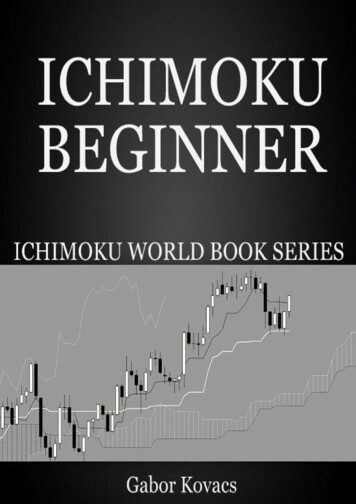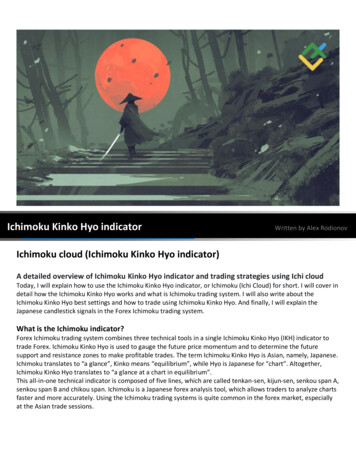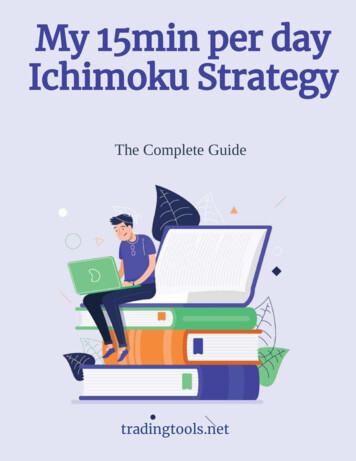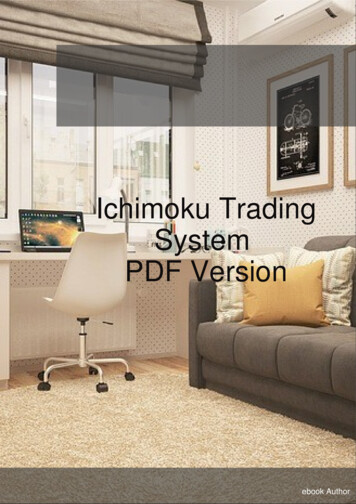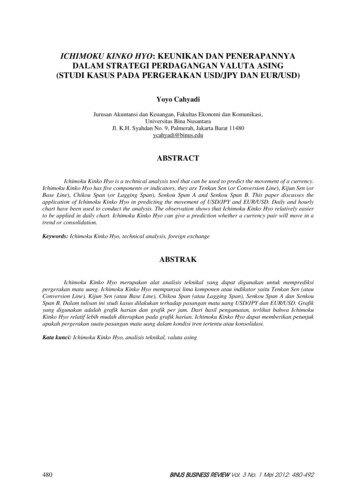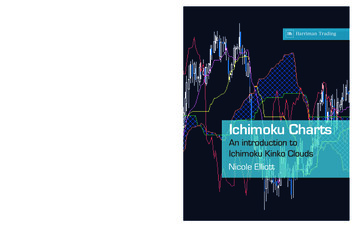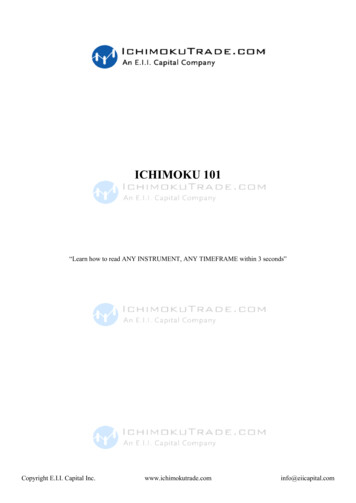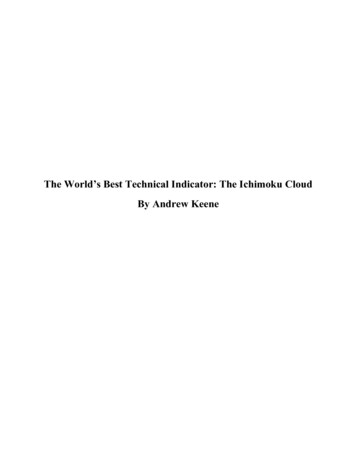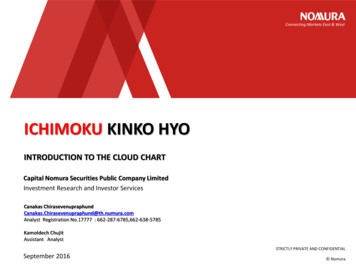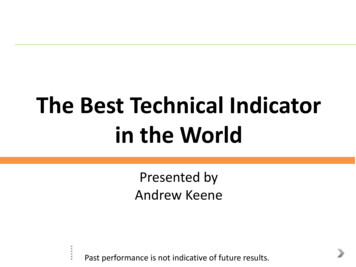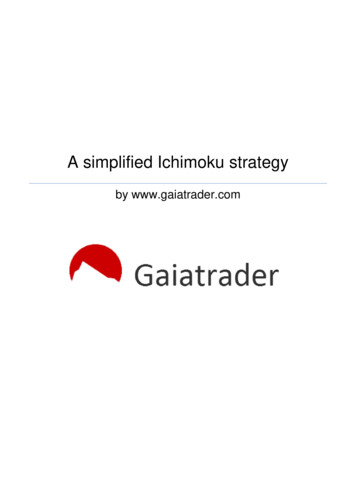
Transcription
A simplified Ichimoku strategyby www.gaiatrader.com
Risks / DisclaimerBefore you read this document, a few cautionary notes:Trading foreign exchange on margin carries a high level of risk, and may not be suitable for allinvestors. Before you start any form of market activity, you should be aware of all the risksassociated with trading.Please do not trade with borrowed money.You should carefully consider that you could quite easily incur losses of part or all of your capitaland therefore, you should never speculate with money that you cannot afford to lose.Any advice, opinion, news, research expressed in this document (and on the www.gaiatrader.comwebsite) is for educational purposes only and does not constitute investment advice in any way.Gaiatrader.com will not accept liability for any loss, damage, including without limitation to, any lossof profit which may arise directly or indirectly from the use or reliance on such information.Please note that past performance of any trading system or methodology is not indicative of futureresults.Simplified Ichimoku strategy – www.gaiatrader.comPage 1
A simplified Ichimoku systemby www.gaiatrader.comFirst of all, let me say that the system I trade is a simplified Ichimoku system derived from a strategycreated by Vince Vora at Tradingwins.com. I have used the basics of his system and customized itto add a few features that make it more precise and useful to me (if you wish to see the initialsystem you can visit the Tradingwins.com website). It relies quite heavily on the Ichimoku Kinko Hyosystem, although it is stripped down version of it and has a few add-ons.It is a simple system based on a few indicators that tells you in a second whether you have a tradesetup or not. It can be traded with an extremely low risk level, I personally use a 1,5% risk onindividual trades.Before I go any further, please note that this document assumes that you are already familiar withForex and Forex trading, we will not teach you to trade Forex here. If however you are a beginnerand need advice on resources to help you learn the skills of Forex trading, you will find a fewrecommendations here: rex-trading/Now, let me take you through the characteristics of this system, which is basically a momentumcatching strategy.Which market ? what timeframe ?This system works on any market, any timeframe. I use it to trade forex on the H4.Due to my day job I can't afford to watch the market more than twice a day, that is early in themorning (around 7-8 AM GMT and in the evenings around 9-10 PM GMT). For that kind of trading,the H4 is ideal because it will give you a reasonable volume of trades and a good grip on themomentum moves of a pair without forcing you to keep a constant watch on your trades.What market conditions are we looking for ?Since this strategy aims at catching trending moves, we are looking for clean charts and want toavoid cluttered pairs where volatility is high with unclear price directions, violent swings or spikes, Two examples of what I mean below:Simplified Ichimoku strategy – www.gaiatrader.comPage 2
Clean chart, clear trendCluttered chart, high volatility, spikes, swingsSimplified Ichimoku strategy – www.gaiatrader.comPage 3
What indicators ?The system uses five indicators, that might seem a lot, but they all have a function and actually theyare a tremendous visual aid for reading graphs and to me they make things much simpler.The Ichimoku cloud and Kijun SenThe Ichimoku Kinko Hyo system is a very elaborate but simple system devised by a Japanesejournalist named Goichi Hosoda in the late 1930s and released to the general public in the late1960s after 30 years of testing and improvement. It is a very complete system giving an instant viewof market conditions, possible entries, exits, support and resistance levels and key past and futuremarket levels. Literally, Ichimoku Kinko Hyo translates as “one glance equilibrium chart”.The original system consists of five lines named Tenkan-Sen, Kijun-Sen, Senkou Span A, SenkouSpan B and the Chikou Span. What we call the Ichimoku cloud is the area between the SenkouSpan A and Senkou Span B, it is usually coloured.Below is a representation of the system and the five lines that compose it (we only use three ofthem):Simplified Ichimoku strategy – www.gaiatrader.comPage 4
The Ichimoku system is a moving average based trade identification system. It is quite elaborateand novice traders might find it difficult to read. However, in our trading system we are only usingtwo of the core components which are the Kumo cloud and the Kijun Sen, since the informationthey provide is sufficient for the kind of market conditions we want to identify.The cloud (also named Kumo in Japanese) is the area between Senkou Span A (also named SSA)and Senkou Span B (SSB), whose definitions are the following: SSA (Tenkan Sen Kijun Sen) / 2 plotted 26 periods ahead SSB (highest high lowest low) / 2 calculated over the past 52 periods and plotted 26periods aheadThe kijun Sen is defined as: Kijun Sen (highest high lowest low) / 2 for the past 26 periodsAnd for reference only (because we do not use them) the other lines are defined as: Tenkan Sen (highest high lowest low) / 2 for the last 9 periods Chikou Span today’s closing price projected 26 periods back on the graphBasically, what the cloud and Kijun Sen will tell us is the following: Kumo Cloud: when price is above the cloud we have an uptrend (we only trade long), whenit is below the cloud we have a downtrend (we only trade short) and when price is inside thecloud we have a neutral situation (no trade). The projected portion of the cloud can also beused as an indication of future market conditions. The height of the cloud is a representationof volatility, so a thinner cloud would indicate lower volatility, and a thicker cloud willrepresent stronger areas of support and resistance. The SSB is the stronger of the two linesand will generally form solid S/R levels. Markets are said to be bullish when SSA is aboveSSB, and bearish when SSA is below SSB. A crossing of SSA and SSB lines (usuallytriggering a change in the cloud color) is called a Kumo twist and can be a sign of potentialtrend inversion.Simplified Ichimoku strategy – www.gaiatrader.comPage 5
Kijun Sen: this line is used as a confirmation line and can be used as support or resistance.It is one the system’s stronger lines and usually a good indicator of future price movement.In our system its slope is particularly important, so we use it both as a confirmation of thetrend and as a potential trigger for exits being a representation of significant support orresistance lines.A 21 period Exponential Moving Average (21 EMA)Moving averages are the single most used indicator in trading. But let’s be clear: they do not predictfuture price movement, they just represent the current direction of a trend. There are many differentforms of moving averages (simple (SMA), exponential (EMA), weighted (WMA) ), here we use the21 period EMA. Exponential moving average reduce the lag by giving more weight to recent prices,therefore we prefer it to SMA. It also tends to be one of the most widely used moving averages, andas such it is kind of a self-fulfilling prophecy since a lot of traders are always going to react around it.In this system it is used to confirm a trend, we will be looking for strong slopes as indicators ofstrong up or down trends.Good slopeWeak slope (no trade)The RSI set to 7 periodsThe RSI is the Relative Strength Index. It was created by Welles Wilder in 1978. It isan oscillator type indicator that moves up and down on a scale from 0 to 100 and identifies thespeed and change of price movements.Simplified Ichimoku strategy – www.gaiatrader.comPage 6
The formula to calculate the RSI is the following: RSI 100 - [100 / (1 RS)] where RS is theRelative Strength average gain / average lossIn the standard setting of the RSI, the average gains (loss) are calculated by adding all the gains(losses) for the past 14 periods. We use it with a setting of 7 periods as we want to use it totrade quite a short cycle.It is commonly accepted that the RSI has the following index thresholds: A reading of 30 or under is considered "oversold" and identifies potential price increase A reading of 70 or higher is "overbought" and identifies a potential price decrease A reading of 50 is considered neutral, and crossing that mark is usually the indication that atrend is forming. For that reason, in this system we use the bounce on the 50 mark asconfirmation that an uptrend or downtrend is resuming (see example below)Bill Williams FractalsFractals were developed by Bill Williams as part of a system that he created mixing the ChaosTheory with Human Psychology. Taken alone, fractals are indicators that actually break largertrends into smaller and simple reversal patterns. A fractal is composed of five or more bars, andthere are two types of fractals: Up fractals: a bullish turning point occurs when there is a pattern with the lowest low in themiddle and two higher lows on each sideSimplified Ichimoku strategy – www.gaiatrader.comPage 7
Down fractal: a bearish turning point occurs when there is a pattern with the highest high inthe middle and two lower highs on each sideThe fractals are turning points, and we will use them for our stop loss placements (initial andtrailing). The idea is that in a long trade, we will place our stop at the most recent red fractal and in ashort trade we will place our stop loss at the most recent green fractal (see further down stopplacement).See a representation of fractals below, swing lows are the red fractals and swing highs are greenfractals.Entry rulesNow that we’ve gone over the indicators and timeframe, let’s take a look at the entry rules. They arevery simple and easy to remember, which makes this system very straightforward because it isnearly 100% rule-based (trader discretion is always necessary in any system):The first thing you should do is check that no major market announcement is on the docket for thepair that you are trading (rate announcement, central bank conference, macro-economic figuresrelease, .), that is very important since it could bring uncontrolled volatility to the pair.For a long trade, the following conditions need to be met: price should be above the kumo cloud, indicating an uptrend (no trade if price is in the cloudor below);Simplified Ichimoku strategy – www.gaiatrader.comPage 8
the 21 period EMA should have an upward slope (avoid flat) as illustrated previously, andideally the Kijun Sen shouldn't be in a flat position either because that would mean we’re notreally making higher highs on a medium term perspective. There will however be somecases of entry when the Kijun is not yet sloping upwards; this will be a discretionary decision,the most important is the 21 EMA; the idea is to catch a swing low on the uptrend and enter when the trend resumes. To timeour entry, we use the RSI as a gauge of speed and momentum of price movement, andtherefore we need it to dip towards the 50 mark and bounce back up again after hitting it.The signal candle will be the one where the RSI goes back up. enter on a break of the high of the signal candle.For a short trade, things should be the exact opposite: price should be below the cloud, indicating a downtrend (no trade if price is in the cloud orabove); the 21 period EMA should have on a downward slope (avoid flat) as illustrated previously,and ideally the Kijun Sen shouldn't be in a flat position either because that would mean we’renot really making lower lows on a medium term perspective; the idea is to catch a swing high on the downtrend and enter when the trend resumes. Totime our entry, we use the RSI as a gauge of speed and momentum of price movement, andtherefore we need it to move towards the 50 mark and bounce down up again after hitting it.The signal candle will be the one where the RSI goes back up. enter on a break of the low of the signal candleIn both long and short entries, it could happen that the RSI doesn’t exactly hit the 50 mark, I thinkthat can be ok if it remains in a reasonably tight zone around the 50 level and if all other conditionsare met, especially the slopes on EMA and Kijun. That is left to trader appreciation but I have foundto miss significant market moves if I get too strict on an exact hit of the 50 mark.StopsFor stop-loss placement I have already explained that I use fractals. Again, it is a simple andstraightforward rule. The reason for using fractals is that they represent key short term swing highsSimplified Ichimoku strategy – www.gaiatrader.comPage 9
or lows. If I’m going long and the previous up fractal (see above for definition) is broken by adownward move then my conditions for an uptrend are no longer met. And the same goes for ashort trade. If a down fractal is broken by an upward move then my conditions for a downtrend areno longer met.Trade management and exitsI usually trail my stop to the next fractal as price moves in my favor, but since I try to keep my riskextremely low I will often move my stop to break-even without waiting for a fractal if I have reached1R (one times my risk).Exits are very discretionary and depend heavily on your money management strategy. Severaloptions are open: exit when price crosses the Kijun or EMA exit when price hits the cloud exit at a certain level of gain (this is what I use most often) exit before significant market announcements, weekends, As explained my strategy is to trail my stop with fractals but when price reaches R3 (three times myrisk) I will directly move my stop-loss just beneath it, since I never want to give back an inch ofprofit on an R3 trade. That is an essential part of my money management, and the reason why thisstrategy is profitable for me even if I hit a 30 to 40% win rate.Money management and riskI use a 1,5% risk maximum on any given trade, with an overall of 5% on concurrent positions. That’svery conservative, I know it sounds small but believe me with a few good trades the performancecan be excellent. Anyway, I like to keep it that way because that’s the amount of risk that I amcomfortable with, and that is key. You cannot trade with amounts that keep you awake or have youchecking prices every minute. That is simply impossible and usually creates a psychological biasthat will prevent you from applying your rules. Experience has proven that keeping my losses at aminimum is absolutely crucial. I make most of my monthly profit with my best 3 to 5 trades, the restof them being break-even, a small loss or reasonable profit (I have around 20 to 30 trades a month).Simplified Ichimoku strategy – www.gaiatrader.comPage 10
Pairs tradedI don’t think this is an essential part of the system, because basically as I said it works with anymarket. Anyway, here are the pairs I trade :EUR/USD, GBP/USD, AUD/USD, USD/JPY, EUR/GBP, NZD/USD, EUR/JPY, XAG/USD (silver),XAU/USD (gold), GBP/JPY, EUR/AUD, GBP/AUD, USD/CAD, EUR/CAD, EUR/NZD, AUD/CAD,AUD/NZD, CAD/JPY 18 pairsFinal words: a 15 minute per day systemI have a day job. I never trade at work. I can only trade from home twice a day and I have a family Ilike spending time with. With this simple system (nearly 100% rule-based) it takes me five minutesin the morning and five minutes in the evening to scan the 18 pairs that I trade, and a little more if Ihave open positions, but that’s it basically this is a 15min per day system, no interpretations, nosplitting hair, you either have a setup or you don’t. The toughest part is managing trades and mainlydeciding on exits.It has been a profitable system for me so far but I believe my strict money management also hashad a key role to play. I started making consistent profits when I lowered my risk, and never everbended my rules. You have to understand that the system is only 20% of the journey, the rest ismoney management (low risk and never give back profits), consistency and courage (stick to therules in drawdowns).Well, there you have it, if you want to follow my daily performance using this system that I tradeevery day I post my trades on my website www.gaiatrader.com and also on Facebook (GaiaTrader), Twitter and Google . The website includes the monthly performance of my account. Sothere, you can judge by yourself and see if this system is appropriate for you.Safe trading.GaiatraderSimplified Ichimoku strategy – www.gaiatrader.comPage 11
Simplified Ichimoku strategy – www.gaiatrader.com Page 5 The Ichimoku system is a moving average based trade identification system. It is quite elaborate and novice traders might find it difficult to read. However, in our trading system we are only using two of the core components which are the Kumo cloud and the Kijun Sen, since the informationFile Size: 596KB
